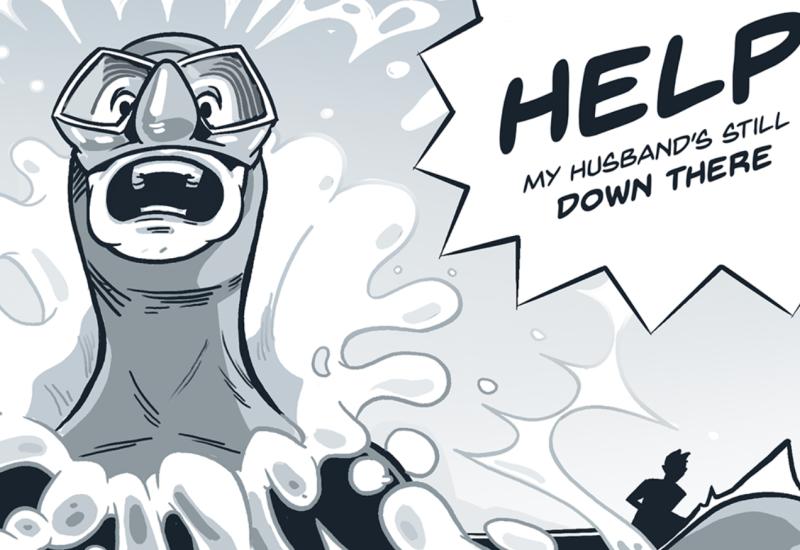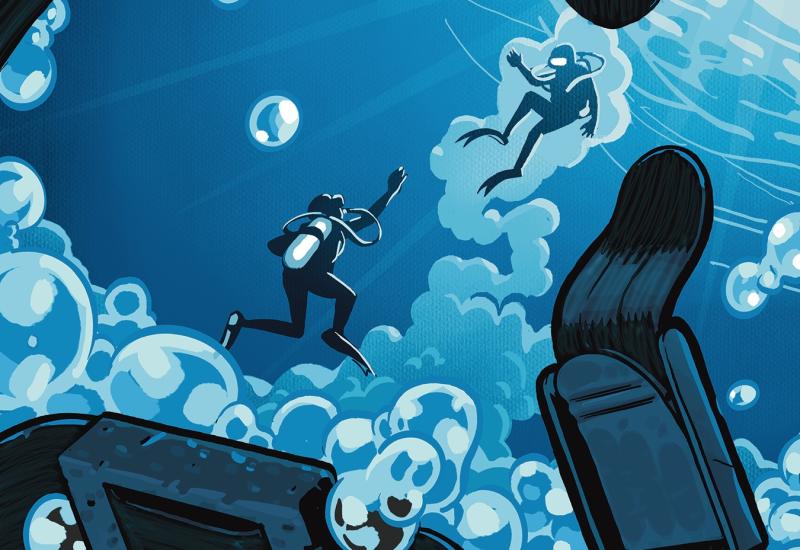A Drysuit Disaster | Lessons for Life
The dive started with some difficulty, but after a few minutes Tom settled down and figured out his buoyancy in the drysuit. This was his first dive using it; his buddy had given him a quick overview on what he needed to do. Tom wasn’t comfortable with the suit, but he had to admit it was keeping him warm in the chilly water around the wreck. His buddies signaled it was time to ascend, and Tom began swimming for the surface. He at- tempted to release air from his BC, but nothing came out—then he remembered all the air was in his drysuit. But by then, he was already ascending much too fast.

Carlo GiambarresiLack of training leads to a fatal ascent for a new drysuit diver.
THE DIVER
Tom was a 53-year-old male with an advanced open water certification. He'd been diving for one year and was in good health, with no known medical conditions. He'd logged about 40 dives.
THE DIVE
When Tom’s buddies told him they were going to take a special day trip to dive on a wreck, he was in. He had heard stories and seen photographs, and was ex- cited about the dive. Although it was May, the water was cold, with surface temperatures in the mid-50s and closer to 50 degrees at the bottom. Tom rented a drysuit from a local dive shop, and one of his buddies told him how to use it.
They planned to make two dives to the wreck; its main deck was at about 90 feet of fresh water. They were using a nitrox mix that gave them plenty of bottom time at depth without worrying about no-stop limits.
The dive site was in a river with a strong current, but they made their way down the anchor line without incident. Tom struggled to adjust his buoyancy. He finally got his suit inflated enough that it provided him the needed thermal protection and allowed him to hover. The divers explored the wreck for 30 minutes before deciding to head toward the surface.
THE ACCIDENT
As soon as the group began ascending, Tom was in trouble. He tried to deflate his BC as he ascended, but it took him a few seconds to remember that wasn’t where his air was. He attempted to release air from his drysuit, but it was too late. He was already ascending rapidly. Witnesses on the surface said he broke the surface with a splash in a cloud of bubbles. He lost consciousness immediately. One of his buddies had followed Tom to the surface and got to him a minute later. The buddy immediately towed him to the dive boat.
The boat captain realized the dire situation. With other divers providing CPR and first aid, he alerted authorities and headed toward emergency medical care at maximum speed. Although the captain reacted as quickly as possible, Tom was pronounced dead upon arrival at a medical care facility. The autopsy report wasn’t released, but it is reasonable to conclude that Tom died due to an air embolism caused by a rapid ascent.
More Lessons for Life
ANALYSIS
A drysuit does a fantastic job of keeping you dry in cold-water environments, down to near-freezing water temperatures for ice diving. But like any gear, you have to know how to use it. In the same way you wouldn’t just throw on a BC and regs and jump in the water, you need to receive training on how to use a drysuit before making a dive.
Drysuits work by keeping a layer of air inside the suit, which insulates the diver well. You have to add more and more air inside the suit the deeper you descend because the air compresses. When diving with a drysuit, you use your BC for surface buoyancy, to hold your cylinder (of course) and as backup buoyancy if your drysuit has a problem. With most types of drysuits, at depth you use only your suit to control buoyancy, though with a few types of drysuits, and in tec diving, you may still use your BC.
Witnesses on the boat said that Tom didn't seem comfortable with his dry- suit before entering the water, and one of his buddies coached him through the setup. When it came time to begin their ascent, Tom’s training and muscle memory kicked in. He began swimming up and reached up to release air from his BC. That didn’t accomplish anything.
It was only then that he remembered to release air from the suit using the valve on his shoulder. By that time, the air in his suit was already expanding and he was ascending rapidly. General guidelines for a normal ascent are 1 foot every two seconds, or 30 feet per minute. By those standards, Tom needed about three minutes to ascend from 90 feet to the surface. He made it in six seconds.
Tom immediately lost consciousness on the surface. Combined with a rapid ascent, this is a textbook description of an air embolism. It begins with a lung over expansion injury. The air in Tom's lungs expanded so rapidly it tore a hole in the alveoli and escaped into his lung cavity. The pulmonary barotrauma to his lungs allowed that expanding air to enter his circulatory system.
An arterial gas embolism occurs when air enters the arterial circulation and sends an air bubble directly to the brain, causing stroke-like symptoms. The only way to prevent or avoid this situation is to follow your training.
If you need to make a rapid continuous ascent, keep your airway open, exhaling all the way to the surface. Tom was likely panicked and struggling with his gear. Because his ascent was so rapid, it is questionable that he'd have been able to vent enough air from his lungs even if he had been trying.
LESSONS FOR LIFE
• Seek training from a certified dive instructor in equipment and techniques that are new to you.
• If you feel uncomfortable with a dive or a piece of equipment, ask for help or seek additional training. Don’t simply struggle with it from pride or fear of embarrassment.
• Ascend slowly from every dive while breathing normally and keeping your airway open. Make a safety stop.
About Lessons For Life
We're often asked if the Lessons for Life columns are based on real-life events. The answer is yes, they are. The names and locations have been removed or altered to protect identities, but these stories are meant to teach you who to handle a scuba diving emergency by learning from the mistakes other divers have made. Author Eric Douglas takes creative license on occasion for the story, but the events and, often, the communication between divers before the accident are entirely based on incident reports.










